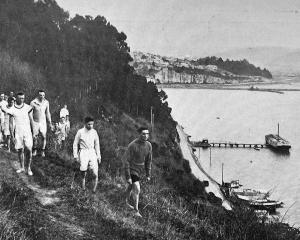
These enterprising pioneers had been on the water 109 days and many a word of thankfulness was uttered when they landed at Napier, then an insignificant town.
After spending a few days in Napier for the purpose of getting their land legs, the male members of the band commenced their journey on foot to Norsewood, their luggage being carried on wagons.
The journey occupied three days, and on Monday, September 25, 44 years ago, the first settlers arrived in the then dense bush, where the town of Norsewood is now situated.
The various farms being allotted to them, they set to erecting dwellings for the women folk, who followed the men some two weeks later.
It is hardly necessary to mention the terrible hardships these early colonists had to contend with.
Without roads, all their stores were taken on pack horses, and in many cases men were obliged to carry them on their backs.
They assisted in the felling of the bush and the forming of the now magnificent roads.
Bush fires destroyed their homes, but the spirit of courage had not been killed by the terrible hardships, and they rebuilt in the hope that as time went on they would be rewarded for their efforts.
There was no outlet for the produce from their farms, and it was a common sight to see the wives of the struggling settlers carrying their baskets of eggs or butter to Kopua and other places along the railway then being formed.
Eighteen years ago the Norsewood Co-operative Dairy Company was formed, and it was greatly through the forming of this company that valuable assistance was given to many a pioneer settler.
Father Time has carried away many of that pioneer band, and in Norsewood today only 21 remain, whilst a few others reside in other parts of New Zealand.
• The Army has (says a London paper) started to grow its own potatoes.
Instructions have been sent, or are being sent, from the War Office to every command, indicating the lines which should be followed.
Military requirements are very large, and little more than half the usual supplies of potatoes are coming into the markets, with the result that pre-war prices to the public are nearly doubled.
If the Army can supply most of its own needs the situation will be eased.
The potatoes are to be planted in rows between the huts.
A number of men are being told off each day for digging, and others are being asked to help in spare time.
It is understood that instructions will soon be issued for the growing of vegetables.
• On October 2, 1856, the wooden barque Strathmore, of 450 tons, arrived at Port Chalmers, after a voyage of 98 days from St. Katherine’s Docks.
She carried 180 passengers, among whom were Sir John Richardson (afterwards Superintendent of Otago), Dr Hulme (for many years Hospital doctor in Dunedin), Mr Colin Allan (who became immigration officer in Dunedin), and Dr John Hislop (afterwards Secretary of Education).
We are indebted to a correspondent in Timaru for a reminder of this anniversary.
Our correspondent adds that the Strathmore was a new vessel, built at Dundee, and that she was owned by Messrs Young, Fotheringham, and Co., of Glasgow, and chartered by Messrs Willis, Gann and Co. — ODT, 2.10.1916
• COPIES OF PICTURE AVAILABLE FROM ODT FRONT OFFICE, LOWER STUART ST, OR WWW.OTAGOIMAGES.CO.NZ












